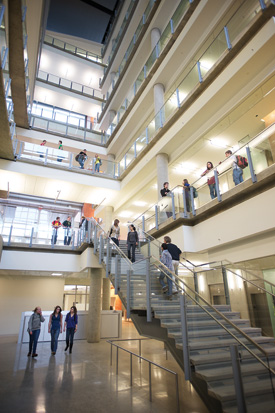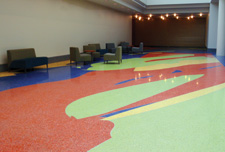Quad has officially been given a facelift. Rising in place of the old demolished V Wing for the past five years has been the new Centennial Centre for Interdisciplinary Science (CCIS). This signature building at the north end of Quad opened its doors to faculty, staff and students in April.
Dean of Science Gregory Taylor says the spring 2011 move-in date marked an historic occasion and is the culmination of many years of planning, fundraising and, finally, construction on the stunning new facility that begins a new chapter for one of Canada's top faculties of science. A $285 million commitment by the provincial government kick-started the project in 2006.
"It is truly a thrill for me to see this initiative come to fruition," says Taylor, who invites science alumni to return to campus this Alumni Weekend (September 22 - 24) to tour through CCIS, check out some of their old haunts, and take part in some of the activities being planned to celebrate the completion. "So many people have been instrumental in getting this project off the ground. It's encouraging to know so many have shared this important vision, one that will not only open the doors to more students, but will also facilitate innovative research and foster discoveries happening at the interface of disciplines."
CCIS will house the Department of Physics, five interdisciplinary science research groups, specialized research infrastructure, lecture halls, teaching laboratories and faculty administration. The Centre is one of only a few buildings of its kind in the world to house interdisciplinary science research teams in one facility and will enable the U of A to continue to attract and retain world-class teaching and research talents.
The main floor of CCIS is one of its most prominent features. The 40,000 square-foot (3,715 square metre) terrazzo floor was designed by artist Scott Parsons who says, "walking across this floor should offer a sense of journey and discovery, like education itself. I would like for people to come, think, sit and wonder - bridging their ideas and thoughts to what it is they have come here to study and what they see in the floor."
The principal organizing element Parsons used for the floor design was to treat the surface with overlapping and interwoven imagery to visually bring together the multiple fields of inquiry in the building. "Art, like science," Parson says, "shares a deeply rooted bond in an emotional, if not spiritual, sense of awe, and artists, like scientists, often begin their work from careful observation."
- Wanda Vivequin
U of A's Oldest Building: Athabasca Hall

Athabasca Hall turns 100 this year. It's interesting to note that as the Centennial Centre for Interdisciplinary Science is the newest building to embrace scientific inquiry, so, too, was Athabasca Hall in its day. "The lecture room of the science faculty is noteworthy for the excellence of its equipment," boasted an October 1911 article in the The Gateway. An "expensive flashlight machine* being an innovation which will place the work on a par with that in many of the best known universities. Adjoining is an admirably equipped class laboratory for the science department."
But Athabasca was never intended to be the first university building to celebrate a centenary. That honour was initially intended to be held by the Arts Building. However, initial construction on that building never got past a hole dug in the ground in 1909 as then-Premier - and Minister of Education - Alexander Rutherford resigned and his successor, A.L. Sifton, balked at using public funds to complete the elaborate structure.
But the need for a physical space for students and staff was still acute, so a new plan was put forward to build three residential halls with temporary classrooms. The idea sat well with Premier Sifton and the multi-purpose Athabasca Hall was built in 1911.
An article in the Edmonton Journal after Athabasca opened quoted U of A President Henry Marshall Tory as saying: "The first university building to be opened this fall and reached by a footpath on the edge of an oat field, has a dining hall for its students, seven classrooms, three laboratories and residential accommodation for about sixty students." At first, Athabasca stood alone in the bush with neither sidewalks nor roads connecting it to anything else. All supplies were hauled in by horse-drawn wagons, which could sink to their axles in mud during wet weather.
Athabasca Hall has gone through many incarnations during its 100 years. From being everything to everyone at the beginning, it later provided dining facilities for the two residences to follow it - Pembina and Assiniboia. Behind Athabasca there used to be a gymnasium that hosted four main dances a year attended by up to 300 people, and, during the Second World War, the three residences became the RCAF Training School, housing up to 1,200 men at one time.
In 1971 it was announced that the three old residence halls would be demolished. But because of their central place in the University's history and in the affections of 60 years of alumni and staff, demolition plans were halted. Athabasca - as well as Assiniboia - was beyond renovation so both were completely rebuilt inside their old shells.
Athabasca Hall was officially reopened on October 8, 1977, by then-Premier Peter Lougheed, '51 BA, '52 LLB, '86 LLD (Honorary), who had been an Athabasca resident in 1952. Interestingly, at that 1977 ribbon-cutting ceremony, for a brief time Athabasca Hall reclaimed its former glory as the newest building on the University campus.
*If anyone knows what a flashlight machine is, we'd like to know.
- Kim Green
U of A's First Science Grad: Decima Eveline Robinson, '11 BSc, '12 MSc
Born in Brighton, England, Decima Robinson emigrated to Edmonton with her parents as a child. She was brilliant in school and excelled at math. But when it came time for university there was, as yet, no post-secondary schooling available in western Canada. And so in 1906 - the year the new Alberta legislature passed the first University Act - Robinson's parents sent her to study at London University in England. When the U of A began classes in 1908, they called her back home to finish her degree in Edmonton.
Robinson was one of three undergraduates - and the only woman - with advanced standing. The others were Albert James Law, '11 BA, and Robert Howard Dobson, '11 BA, '14 MA. She was also the only one seeking a bachelor of science degree. Forty years after graduation, she recalled her first day of class: "My spirits were rather low on registration day, for I couldn't help contrasting my former hopes for a career as a student at Cambridge with the realities, as I pictured them, of a brand new university in the Far West."
But Robinson's forebodings disappeared once she met her classmates and professors, led by the inimitable President Tory, a gold medalist in mathematics from McGill. "I doubt that even now, forty years later, the university could give a better four years' course than we received," she wrote. "I feel that I owe a tribute of thanks to Doctors Tory and Sheldon for my life-long interest in mathematics, to Doctor Lehman for his friendly and competent guidance in chemistry, and to Doctor Broadus for his unequalled lectures in english." Robinson graduated with a major in mathematics. In those early years, the U of A published every student's grades in the University Calendar where her high marks earned her the nickname "Calculus Maid." But she wasn't to be a "maid" for long. Although all seven women in that first class formed the Society of Independent Spinsters - vowing not to marry so that they could pursue careers after graduation - Robinson was not to keep her vow. She fell in love with the 1912 class president, a handsome philosopher and mathematician by the name of Edwin T. Mitchell, '12 BA, '13 MA. The couple married in 1915.
Mitchell took his PhD in philosophy from the University of Chicago, after which the couple moved to Texas where Mitchell taught at University of Texas at Austin from 1923 - 1952. Both Robinson and Mitchell kept in close touch with their U of A professors and fellow students, often returning to Edmonton in the summers to renew friendships and visit with family and their beloved alma mater. Edwin Mitchell passed away in 1953; Decima Robinson passed in 1962.
- Ellen Schoeck,'72 BA, '77 MA




We at New Trail welcome your comments. Robust debate and criticism are encouraged, provided it is respectful. We reserve the right to reject comments, images or links that attack ethnicity, nationality, religion, gender or sexual orientation; that include offensive language, threats, spam; are fraudulent or defamatory; infringe on copyright or trademarks; and that just generally aren’t very nice. Discussion is monitored and violation of these guidelines will result in comments being disabled.